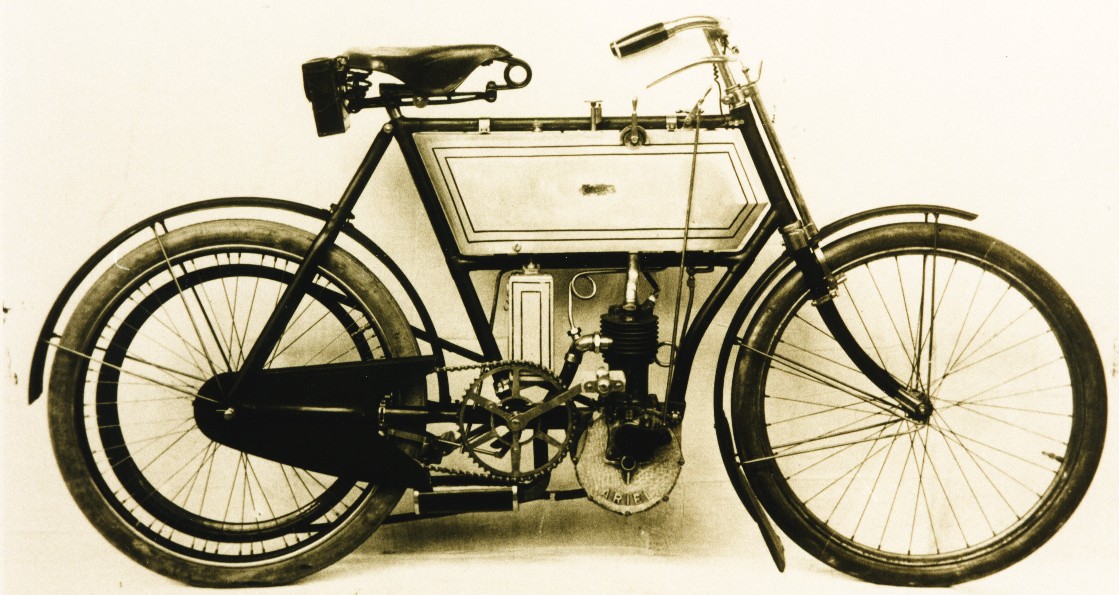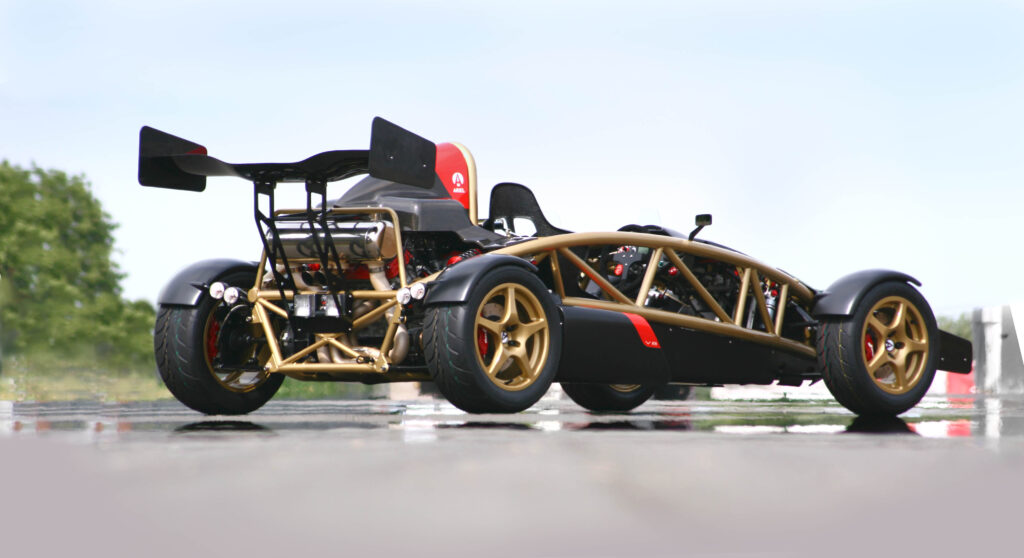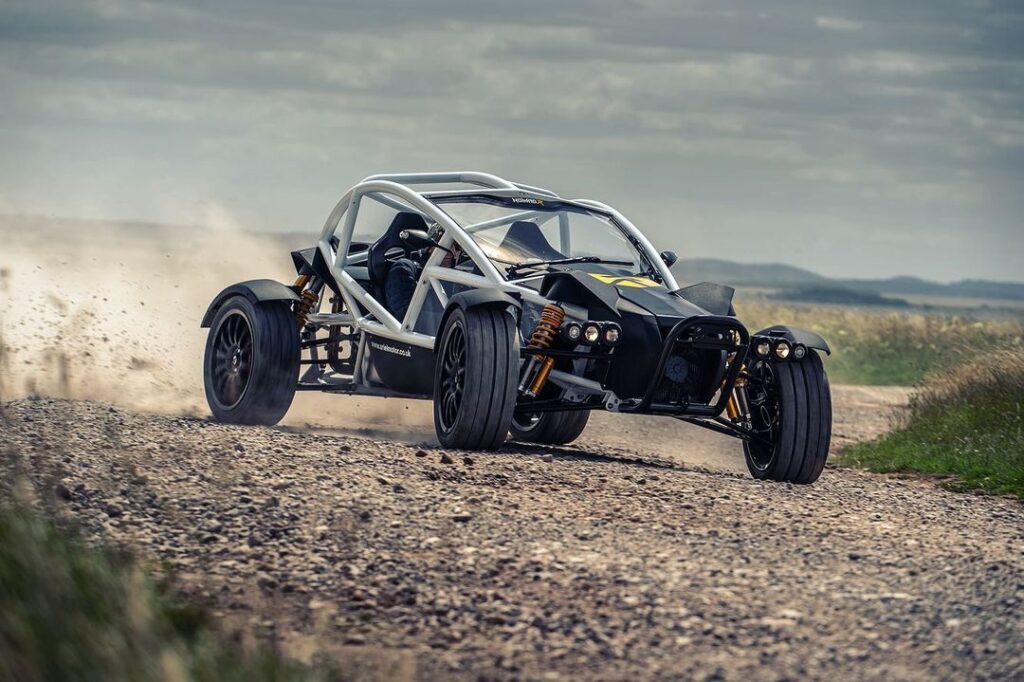
is this the most amazing
car of the CenturY

1871
Ariel Ordinary
We’re justifiably proud of the Ariel history. It started over 150 years ago with what was the world’s first production vehicle – the Ariel Ordinary designed by James Starley. The first all metal bicycle with a lightweight steel frame, revolutionary and patented spoked wire wheels, rubber tyres and steering the Ordinary was at the very forefront of innovation and design. This cutting edge ethos dating back to the 19th Century continues in our philosophy today and we have Ordinary number 47 in our museum.

1890
Ariel Bicycle
With the introduction of ‘Safety Bicycles’ so named because riding the high wheel Ordinary bicycles carried a fair amount of risk, also by James Starley and his nephew John Starley, Ariel continued development on two wheels breaking all cycle records. In 1897 J W stocks, an Ariel factory rider, took the 1 hour record at 32.75mph, one of many records achieved through the decade. Ariel bicycles continued in production until the 1930’s.




1898
Ariel tricycle
With new technology arriving almost monthly towards the end of the century the world had advanced from pedal power to the first commercially available vehicles with internal combustion engines. Among these was the Ariel Tricycle with a 239cc De Dion engine, revolutionary water cooled head and a lot of levers. The tricycle developed into a 289cc Quadricycle in 1900 with the addition of two front wheels, elliptical springs and an upholstered front seat. Taking part in the 1900 1,000 Mile Trial Ariel Tricycles and Quadricycle finished 1st and 2nd in their classes, completing the whole distance and winning various hill climb events along the way. We have a 1901 Quadricycle, one of only two known to survive.

1901
Ariel Minerva
The first Ariel motorcycle was launched in 1901 fitted with a Minerva engine followed by the first Ariel car was built in 1902 featuring a 10hp twin cylinder engine. Using a variety of engines, J.A.P., MAG, White & Poppe, Simplex and AKD V twins Ariel motorcycle and car production increased through the early 20th Century. Development was halted during WW1 as production was moved to producing motorcycles for army dispatch riders so post war motorcycles were very much the same as the pre-war models.


1908
Ariel Grand Prix Racecar
From the early days Ariel has been involved in motorsport. There was an Ariel in the first ever race at Brooklands on 6 July 1907, coming second and giving rise to the legendary bonnet straps seen on Bentleys and Bugattis, but that’s another story. At the second Brooklands event Ariel won their race with the car driven by Ariel Motor Company owner Charles Sangster. Competing in all kinds of events from circuit racing to trials and hillclimbs the cars were designed down to a minimum weight (1100 kg minimum for the 1908 Grand Prix car) or for capacity – one rule for hill climbing was that you had to arrive at the finish with all the passengers you started with



1924
Ariel nine
Ariel continued to make cars until the 1920’s, Jack Sangster introducing first the Ariel Nine initially with a horizontally opposed 748cc twin cylinder engine and later with a more conventional four cylinder engine. This was followed shortly after by the Ariel Ten and then by a long wheelbase model. At £235 the deluxe model included a mirror, speedometer and leather upholstery with an optional starter motor at £2. An achievement of an Ariel Ten was an RAC Trial of 1788 miles in 1924, from Lands End to John O’Groats and back, driven by the famous Donald Healey, then Ariel dealer for Cornwall. The car gave 53.79 mpg, 6,433mpg of oil and used only 5 pints of water and no coasting was allowed down hills. With passengers the car weighed 17½ cwt, 890 kilos and completed the trial with no breakages. We have an Ariel Nine currently undergoing restoration, one of only three we know of in the world.
1926
Ariel Model E Super Sports
Known as the ‘Black Ariels’, produced from 1926 to 1930, the motorcycles incorporated a staggering rate of development. Legendary engineer Val Page designed new engines, brought new production techniques and modernised the factory. The ‘Iron Horse’ legend was born and various feats, dreamed up by Ariel Sales Manager Vic Mole, were achieved such as riding 10,000 miles without stopping at all, climbing Mount Snowdon and crossing the English Channel, all on an Ariel motorcycle. There is talk of repeating the Channel crossing…




1935
Ariel Red Hunter
Acknowledged as one of the most beautiful bikes of its time the Red Hunter appeared in 1932 and set the style for Ariel. With a 500cc, 4 overhead valve engine the bike spawned both 250 and 350cc versions as well as competition success during the 1930’s. In September 1939 a Red Hunter earned the Brooklands Gold Star lapping at over 101mph, just before Ariel once again turned production over entirely to military motorcycles. Over 30,000 350 W/NG models were produced over the following 5 years.


1949
Ariel VCH
Ariel built on the competition successes of the Red Hunter with the VCH, sold only to dealers who would compete on them the bike feature magnesium engine cases and a tuned 500cc engine. The following HS and HT models, of a similar design, were a milestone in scrambles and trials, racking up extraordinary competition successes. Probably the most famous trials bike of all time is GOV 132, ridden by the legendary Sammy Miller. Our HT5 is signed by Sammy and he also took an Ace up the hill at Goodwood.

1955
Ariel Square 4
Probably the most famous Ariel motorcycle, the Square 4 was introduced in 1931. Four cylinders, two crankshafts, chain driven overhead camshafts – Edward Turner’s design was truly revolutionary. Originally introduced as a 500cc, progressing to 600cc for sidecar use and later to a 1000cc the Square 4 was produced in various iterations for nearly 30 years. In 1933 Ken Bickell managed a 110mph lap at Brooklands on his supercharged Square 4. A bumpy track in a car this was no mean feat and a record in its day.



1963
Ariel arrow
Introduced in 1958 the Ariel Leader was another radical Ariel design. Pressed steel frame, 2 stroke engine, trailing link forks, fuel tank under seat and integrated panniers the Leader also featured a headlamp leveller and the first indicators on a British motorcycle. The Arrow was a stripped down version of the Leader launched in 1959 with the Golden Arrow, a tuned version, following the next year. We have a racing Arrow registered for Classic Racing which is tuned and fitted with expansion chambers – it’s loud!



1971
Ariel Healey 4
With practically the entire British motorcycle industry in terminal decline the Healey Square 4 was launched by brothers George and Tim Healey in 1971. Featuring oil in frame, a tuned and revised 1000cc Square 4 engine, the Healey 4 weighed less than a Honda 250, handled well and was capable of over 125mph, which was pretty good for 1973. With only the two brothers, one mechanic and a secretary in the company only 28 bikes were made, the last one in 1977 being one of the last British motorcycles made for many years..
1996
LSC
Where the Atom started. With a long held dream of building a new ‘Lotus 7’ Simon Saunders started to put his ideas into reality while working as a Senior Lecturer in Transport Design. Together with student Niki Smart and input from Stewart Grand Prix (to become Red Bull Racing), TWR, British Steel, Ford Motor Company and friends from Aston Martin the LSC or Lightweight Sports Car was born. Shown for the first time at the 1996 British Motor Show the car received great acclaim as the most interesting car at the show. After subsequent months of testing and development the process of designing the all new Atom started from scratch spanning the next three years.




2000
Ariel atom
Launched in 1999 with first deliveries in 2000 the Atom quickly became the star of the developing trackday scene and captured the motoring world’s imagination. Road legal and with an 1800cc K Series Rover engine in 120bhp, 160bhp and 190bhp output the car was the original ‘NO DOORS NO SCREEN NO ROOF’ and demonstrated that light weight gave giant slaying capability, no matter what the opposition.

2003
Ariel atom 2
The introduction of Honda power with the 220bhp Civic K20A Type R engine, to replace the Rover engine, gave rise to the Atom 2 in 2003. Distinguishable by the lower air box the Atom 2 had a host of design refinements as Ariel continued to develop the car both on road and on track. The supercharger option arrived in 2005 and not only gave the Atom that unmistakable noise but started ticking off the records, consistently winning 0-60mph and 0-100-0mph challenges against all comers. It’s also the car that pulled Jeremy Clarkson’s face off.


2007
Ariel Atom 3
The new K20Z4 Type R engine prompted the move to the Atom 3 with a completely revised chassis (can you spot the difference?) and other changes from the Atom 2. With normally aspirated power up to 245bhp and supercharged to 300bhp the Atom continued to evolve with other refinements to suspension, bodywork and systems throughout the car. A small run of 10 Atom Mugens based on the Atom 3, with a normally aspirated 270bhp Mugen engine revving to 8600rpm, were made in 2011.




2010
Ariel atom V8
A limited edition run at 25 cars the V8 took the Atom 3 to a new limit. The option of 475bhp or 500bhp 3 litre V8 revving to 10,000rpm gave the Atom a power to weight of over 900bhp per tonne. An pneumatically controlled Sadev sequential gearbox changed gears in less than the time it takes to blink and became the world’s fastest accelerating car as well as holding the Top Gear track record for over two years. Be it a road test, a 0-60 challenge or a Top Gear lap we always use a car that is road legal and that a customer can buy. Anything else seems a bit daft to us.

2013
Ariel atom 3.5
With many lessons learnt from development of the V8 and introduction of the latest Honda Kseries engine the Atom 3.5 was launched in 2012. Called the 3.5 because there wasn’t a significant change to the powertrain, but refinements to suspension, steering, engine management, bodywork and control interfaces – although much was carried over from the Atom 3. It does sound a bit like a software title but we know and you know what it is. A sequential Sadev gearbox, supercharged power increased to 310bhp and modifications to suspension resulted in the 350-367bhp Atom 3.5R in 2013, multiple winner of performance car awards and road tests. A great car – we still have ours!



2014
Ariel ace
As Ariel was best known for the motorcycles we thought it was about time there was a new one – and so the Ace was born. Like it’s 4 wheel stable mate the Ace uses a Honda engine and as a nod to the renowned Square 4 we chose a large capacity V4, the VFR1200. Never seen previously the frame is made from solid billet aluminium, taking over 70 hours of machining, and re-introduced the option of Ariel’s own girder forks. Available in manual of DCT gearbox the Ace followed the Atom tradition of tailoring to suit customer requirements. A small run of 10 numbered bikes in 2018 called the Ace of Diamonds sold out immediately and the Ace continues in production.





2015
Ariel Nomad
Launched to an unsuspecting world at AutoSport International in 2015 the Nomad quickly won the title of ‘Atom’s mucky brother’. Using the 2.4L Honda K24 iVTEC engine with 235bhp and 300Nm of torque the Nomad used Ariel’s knowledge of lightweight vehicles to go off road, be it green laning, on a rally section or just mucking around in a field. Once again Ariel’s giant slaying ability was demonstrated beating full rally cars around stages while putting the biggest grins seen on drivers’ faces. In 2016 the supercharger option was released taking power to 300bhp and in 2020 the Nomad R with a 2.0L supercharged Honda K20 Z3 engine took power to 335bhp. Mated with a Sadev sequential gearbox and single paddle change the Nomad R was the fastest Nomad made.

2018
Ariel atom 4
It may look like another Atom but there were only 3 carry over parts to the Atom 4 – the pedals, the steering wheel and the fuel cap. Using the 2.0L Honda K20C1 engine the Atom 4 was the first Ariel to be turbocharged, replacing the famous supercharger whine with ‘Darth Vader sucking in your ear’ and developing 320bhp with switchable boost. A complete redesign, the new chassis owed much to the Atom Ti, an R&D project to build a lightweight titanium chassis, the bigger tubes increasing torsional stiffness yet further. An enormous amount of time spent on aerodynamics resulted in the new look and revisiting the suspension geometry provides anti-dive and anti-squat geometry. Once again a multiple award winner the car was Trackday Car of the year, Performance Car of the Year, Britains Best Drivers Car and won the only 5 Star road test from Autocar in 2021.




2023
atom 4R



Ariel Ace – BLACK EDITION

HIPERCAR is GO

